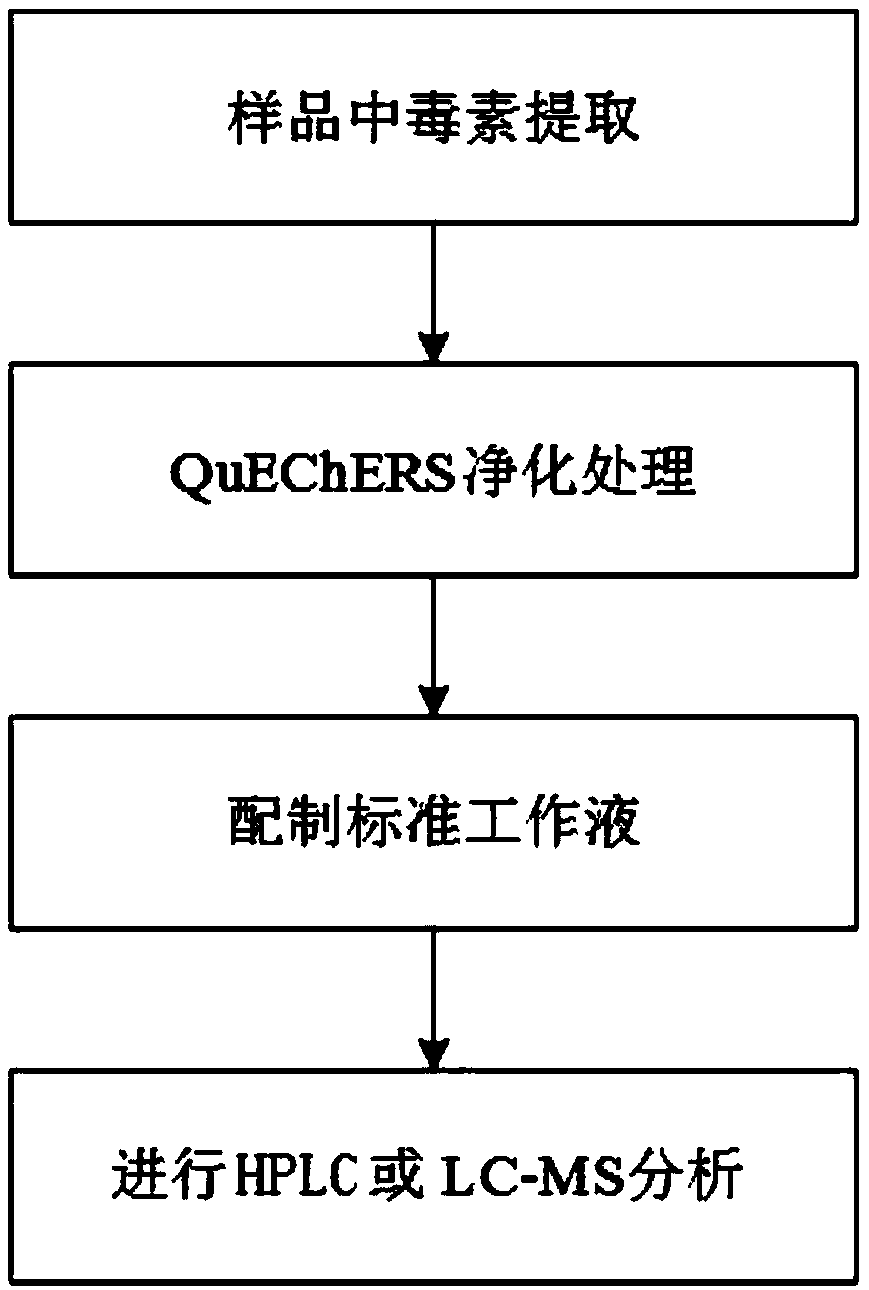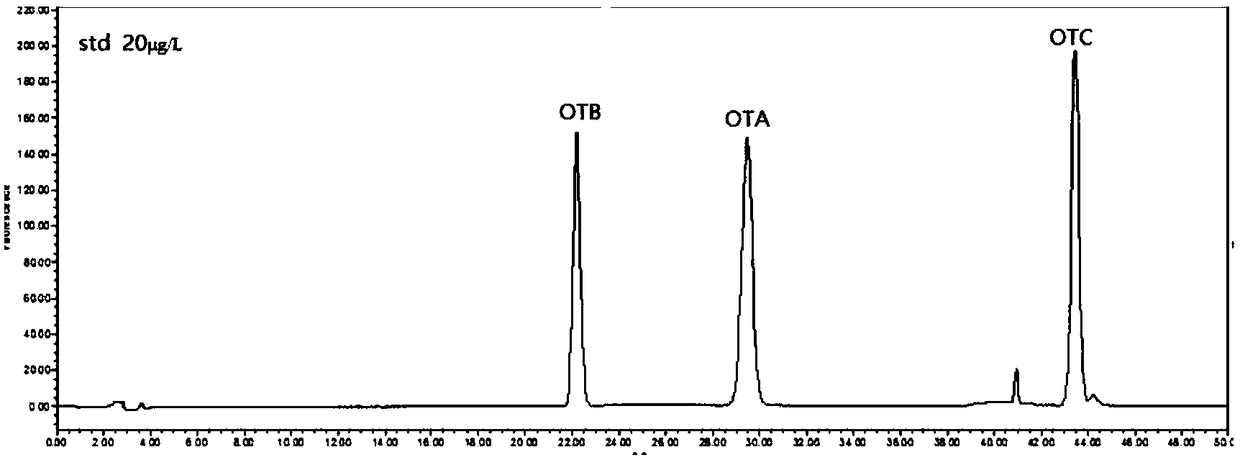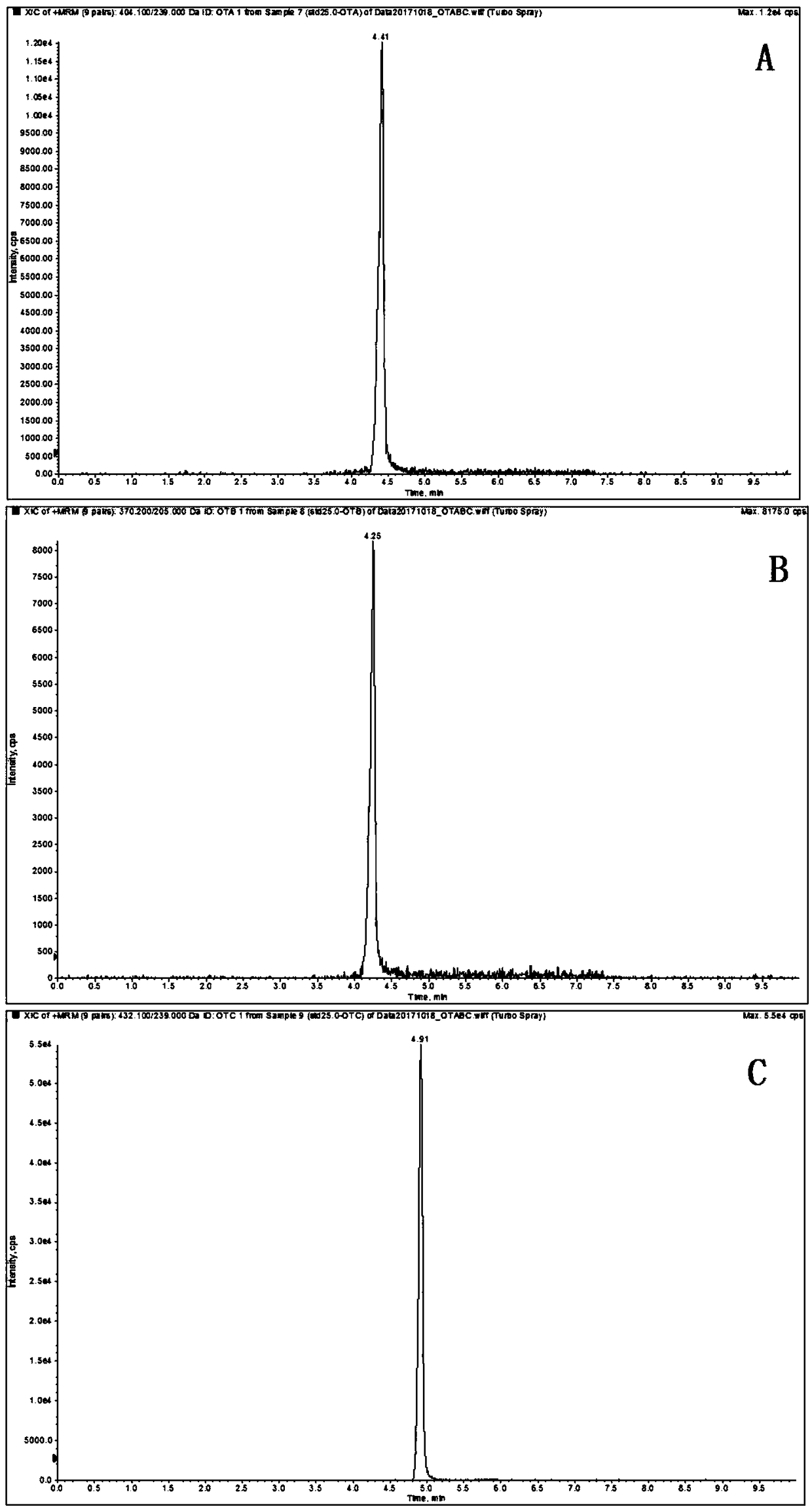Method for simultaneously rapidly determining total amount of three kinds of ochratoxin in samples
A technology for rapid determination of ochratoxin, applied in measuring devices, instruments, scientific instruments, etc., can solve the problems of not being able to detect three kinds of ochratoxin at the same time, not suitable for wine detection, target detection interference, etc., and achieve low detection. The effect of limit value, low cost, accurate data
- Summary
- Abstract
- Description
- Claims
- Application Information
AI Technical Summary
Problems solved by technology
Method used
Image
Examples
Embodiment 1
[0058] The high-performance liquid chromatography detection of three kinds of ochratoxins in wine of embodiment 1
[0059] 1. If figure 1 , a method for simultaneous rapid determination of three ochratoxins in wine, the steps are as follows:
[0060] (1) Sample pretreatment and QuEChERS purification
[0061] Accurately measure 10.0ml of the white wine sample, and then follow the steps in A) below to obtain the liquid to be tested;
[0062] A) Add 10ml of a mixed solvent of acetonitrile and glacial acetic acid (the volume ratio of acetonitrile and glacial acetic acid is 90:10) to the sample, shake or vortex to mix (vortex for about 10s). Then add QuEChERS adsorbent 1 (anhydrous magnesium sulfate, sodium chloride, sodium citrate dihydrate and disodium hydrogen citrate sesquihydrate, the weight ratio is 4:1:1:0.5) 2.6g, shake or Vortex for 10s, centrifuge for the first time (4500rpm for 10min); pipette 1ml of the supernatant into a 1.5ml PE tube, add QuEChERS purification agen...
Embodiment 2
[0076] Example 2 Detection of three kinds of ochratoxins in wine by liquid chromatography-tandem mass spectrometry
[0077] 1. Method
[0078] (1) Sample pretreatment and QuEChERS purification are the same as in Example 1.
[0079] (2) Detection conditions of liquid chromatography-tandem mass spectrometry
[0080] 1) Chromatographic working conditions:
[0081] HPLC column: Agilent ZORBA-LC-C18 column (3.0mm×150mm, 3.5μm) column; column temperature: 40°C; flow rate: 0.3ml / min; injection volume: 20μl;
[0082] HPLC elution conditions: mobile phase: A is 0.1% formic acid, B is acetonitrile;
[0083] Gradient elution program: the elution program of the gradient elution is: the elution program of the gradient elution is: 0.5min: 90% solution A, 2.0min: 10% solution A, 5.0min: 10% Solution A, 5.10min: 90% solution A, 10.0min: 90% solution A;
[0084] 2) Working conditions of mass spectrometry (triple quadrupole tandem mass spectrometer):
Embodiment 3
[0097] Embodiment 3 The optimization of the process condition of the present invention's method
[0098] 1. Optimization of sample pretreatment conditions
[0099] (1) Optimization of Adsorbent 1
[0100] Literature at home and abroad show that the adsorbents analyzed by QuEChERS are mostly anhydrous magnesium sulfate, sodium chloride, sodium acetate, sodium citrate, sodium citrate dihydrate, disodium hydrogen citrate sesquihydrate and so on. Through the dual optimization experiment screening of combination matching and proportioning, the results show that the combination of anhydrous magnesium sulfate, sodium chloride, sodium citrate dihydrate and disodium hydrogen citrate sesquihydrate has a weight ratio of 4 :1:1:0.5, the extraction effect is the best.
[0101] (2) Optimization of Purifier 2
[0102] Through the literature on the analysis of related mycotoxins QuEChERS, the commonly used purifiers are PSA, GCB, C18, neutral alumina, NH 2 , Florisil, SiO 2 etc. Due to ...
PUM
 Login to View More
Login to View More Abstract
Description
Claims
Application Information
 Login to View More
Login to View More - R&D
- Intellectual Property
- Life Sciences
- Materials
- Tech Scout
- Unparalleled Data Quality
- Higher Quality Content
- 60% Fewer Hallucinations
Browse by: Latest US Patents, China's latest patents, Technical Efficacy Thesaurus, Application Domain, Technology Topic, Popular Technical Reports.
© 2025 PatSnap. All rights reserved.Legal|Privacy policy|Modern Slavery Act Transparency Statement|Sitemap|About US| Contact US: help@patsnap.com



